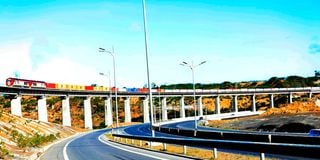Kenya Railways, truckers seal last mile cargo delivery gap

Standard Gauge Railway cargo train leaves the Mombasa Port at Miritini area in this picture taken on September 24, 2022.
What you need to know:
- The move is one of the recommendations by stakeholders to increase use of SGR as a mode of transport.
- KPA aims to increase cargo volumes as regional economies expansion means it has to cater to the increased demand.
Kenya Railways Corporation (KRC) has partnered with trucking firms to address a gap in the last-mile cargo connectivity, which had proved a major bottleneck for customers using its standard gauge railway freight service.
In the new plan, all goods can now be delivered to the doorstep of a client straight from the Port of Mombasa either through bill of lading (TBL) or merchant haulage (non-TBL), an extra cost which traders have been complaining of thus shunning use of the railway.
Transport Cabinet Secretary Kipchumba Murkomen said the move is one of the recommendations by stakeholders to increase use of SGR as a mode of transport.
“Regarding end-to-end logistical services, KPA will enter into agreements with stakeholders such as KRC and truckers to deliver cargo to customer premises. This will ensure cargo reaches to the client on time and at reasonable cost,” said Mr Murkomen.
“To make the northern corridor more efficient and cheaper, the government is working with other agencies to reduce bottlenecks along the corridor with plans underway to sign a memorandum of understanding (MoUs) for implementation of end-to-end solutions,” he added.
Last year, KRC gazetted promotional tariffs to ferry cargo from Mombasa port to Malaba at $860 (Sh132,448) for a 20-foot container weighing up to 30 tonnes, and $960 (Sh147,849) for a container weighing above 30 tonnes.
Drive economic growth
Charges on a 40-foot container weighing up to 30 tonnes stood at $1,110 (Sh170,951) while those above 30 tonnes were levied $1,260 (Sh194,052).
This means, with the last mile problem being addressed, traders will save over $1,200 (Sh184,812) per container if they choose to use the railway over road to transport cargo from Mombasa to Malaba as it costs $2,000 (Sh308,020) per container for those using the road.
The move by the government is in line with the Kenya Ports Authority's five-year strategic plan, which aims at reducing costs and enhancing efficiency.
Mr Murkomen has asked all stakeholders involved in the maritime industry to embrace innovation, collaboration, and adaptability to drive economic growth and attract investments.
“We recognise KPA, which is a gateway of East Africa can play a key role in bringing the cost of goods and services down thus we aim to streamline port operations, reduce logistics costs, and improve the overall efficiency of cargo handling and these measures will undoubtedly contribute to the affordability of essential commodities, making a tangible difference in the lives of our fellow citizens,” said Mr Murkomen.
In the new blueprint launched this week, KPA aims to increase cargo volumes as regional economies expansion means it has to cater to the increased demand.
“The plan resonates with the aspirations of East Africa Vision 2050 on maritime, which is to develop seaports that provide world-class services to facilitate and promote global seaborne trade through the provision of efficient and competitive port services,” said KPA managing director William Ruto.





